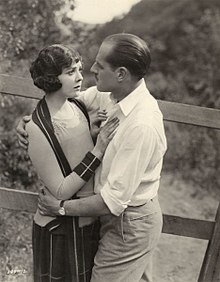Jack Holt (actor)
Jack Holt | |
|---|---|
| File:Jack Holt.jpg | |
| Born | Charles John Holt May 31, 1888 Fordham, New York, U.S. |
| Died | January 18, 1951 (aged 62) |
| Occupation | Actor |
| Years active | 1914–1951 |
| Spouse(s) | Margaret Woods (1916-1951) Three children[1] |
Jack Holt (May 31, 1888 – January 18, 1951) was an American motion picture actor in both silent and sound movies, particularly Westerns.
Early life
Born in 1888 as Charles John Holt,[1][2] in Winchester, Virginia and when in Manhattan, attended Trinity School. He was accepted into the Virginia Military Institute in 1909,[3] but expelled for misbehavior. He ended his fleeting pursuit of becoming an attorney-at-law and took on odd jobs while on the road. He triumphantly rode a horse down a steep embankment into the Russian River in a scene for Salomy Jane, included in the DVD released 2011 anthology Treasures 5 The West 1898—1938 by the National Film Preservation Foundation.[1] He does not seem to have registered for World War I. At the start of World War II, Holt enlisted in the United States Army at the age of 54, at the request of General George C. Marshall so that Holt could be a horse buyer for the United States Cavalry.
Film career

He seems to have started out in Hollywood with stunt and bit parts in serials and at Universal Pictures worked as a supporting player for Francis Ford and his brother John Ford, and Grace Cunard.[1]
Holt's dapper mustache, prominent jaw, and quick-with-his-fists manner, personified rugged masculinity. Holt became Columbia Pictures' most reliable leading man, and scored personal successes in three Frank Capra action dramas: Submarine (1928), Flight (1929) and Dirigible (1931). Holt's no-nonsense characterizations were eclipsed by younger, tough-talking actors like James Cagney and Chester Morris, although he continued to work low-budget action features, mostly for Columbia through 1940. It came to an end when he argued with studio chief Harry Cohn who thought the actor so arrogant that he committed him to a secondary role in a 15-chapter serial Holt of the Secret Service (1941) with accompanying publicity to introduce him to that new type of film product audience but he left Columbia for other studios.
He would become an enduring member of that cowboy fraternity through Trail of Robin Hood (1950) joining others: Roy Rogers, Allan Lane, Tom Keene, Tom Tyler, Kermit Maynard, and Rex Allen. His children established their own film careers: Tim Holt in The Treasure of the Sierra Madre (1948), with Jack as a grubby vagrant and Jennifer Holt, mostly in Universal Pictures westerns. They performed together on the "Drifty" episode of "All Star Western Theater" (KNX-CBS Pacific Network, 1946/47) as a father/son/daughter trio featuring a dramatic sketch and additional entertainment by Foy Willing and the Riders of the Purple Sage.[1][4]
Death


Jack Holt died in 1951 from a heart attack in Los Angeles, California and is buried there in the Los Angeles National Cemetery. He was 62 years old.[1]
Contribution
Jack Holt has a star on the Hollywood Walk of Fame at 6313-½ Hollywood Blvd for his contribution to the motion picture industry. Holt was the visual inspiration for Chester Gould's "Dick Tracy" and Al Capp's "Fearless Fosdick."[1]
Margaret Mitchell, although having no say in the casting for Gone With the Wind (1939), expressed her preference of Jack Holt as Rhett Butler, because her personal favorite, Charles Boyer, had a French accent.[5]
Partial filmography
- Salomy Jane (1914) (uncredited)
- The Master Key (1914 serial)
- The Broken Coin (1915 serial)
- Liberty (1916 serial)
- Joan the Woman (1916) (uncredited)
- Patria (1917 serial)
- The Little American (1917)
- The Secret Game (1917)
- Headin' South (1918)
- The Marriage Ring (1918)
- The Squaw Man (1918)
- For Better, for Worse (1919)
- Kitty Kelly, M.D. (1919)
- Victory (1919)
- The Life Line (1919)
- Crooked Streets (1920)
- The Sins of Rosanne (1920)
- Midsummer Madness (1921)
- All Soul's Eve (1921)
- Ducks and Drakes (1921)
- The Call of the North (1921)
- North of the Rio Grande (1922)
- Making a Man (1922)
- A Gentleman of Leisure (1923)
- Hollywood (1923) cameo
- The Cheat (1923)
- The Marriage Maker (1923)
- The Lone Wolf (1924)
- Wanderer of the Wasteland (1924)
- Empty Hands (1924)
- North of 36 (1924)
- The Thundering Herd (1925)
- Eve's Secret (1925)
- The Light of Western Stars (1925)
- The Blind Goddess (1926)
- The Tigress (1927)
- The Warning (1927)
- The Smart Set (1928)
- Court-Martial (1928)
- The Water Hole (1928)
- Avalanche (1928)
- Submarine (1928)
- Flight (1929)
- The Border Legion (1930)
- Dirigible (1931)
- White Shoulders (1931)
- Maker of Men (1931)
- Behind the Mask (1932)
- Black Moon (1934 film) (1934)
- Whirlpool (1934)
- The Littlest Rebel (1935)
- Storm Over the Andes (1935)
- San Francisco (1936)
- The Great Plane Robbery (1940)
- Holt of the Secret Service (1941 serial)
- Cat People (1942)
- Thunder Birds (1942)
- They Were Expendable (1945)
- My Pal Trigger (1946)
- Flight to Nowhere (1946)
- The Chase (1946)
- Renegade Girl (1946)
- The Treasure of the Sierra Madre (1948)
- Loaded Pistols (1948)
- The Strawberry Roan (1948)
- Task Force (1949)
- The Last Bandit (1949)
- Across the Wide Missouri (1951)
References
- ^ a b c d e f g Internet Movie Database. Biography for Jack Holt. Retrieved on August 2, 2009.
- ^ Source Citation: Year: 1900; Census Place: Bronx, New York, New York; Roll: 1127; Page: 17A; line 15; Enumeration District: 1041; FHL microfilm: 1241127.
- ^ http://www9.vmi.edu/archiverosters/show.asp?page=details&ID=5590&rform=search; viewed 1/18/2014
- ^ http://www.radioarchives.com/All_Star_Western_Theatre_p/ra174.htm; viewed December 25, 2013.
- ^ Anne Edwards, Road to Tara: The Life of Margaret Mitchell (New Haven and New York: Ticknor and Fields, 1983)
